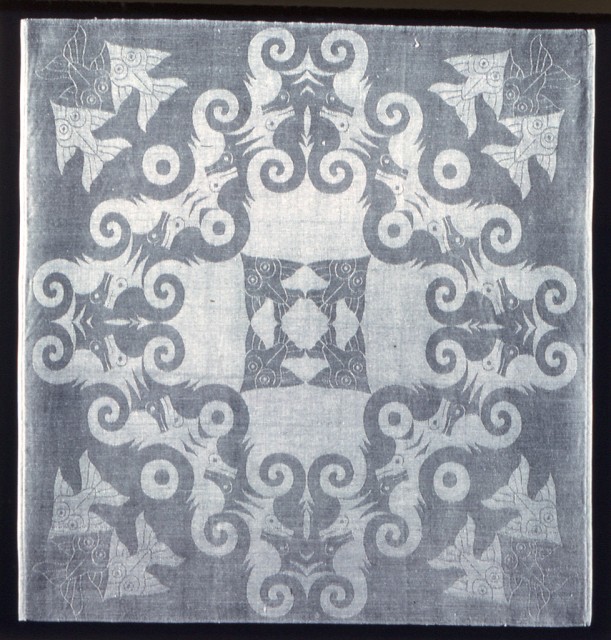Has there ever been a more felicitous pairing of artist and technique than Maurits Cornelius Escher and damask? Escher’s work, which is so dependent on interlocking forms and the seamless use of positive and negative space, is executed here in linen damask, a technique in which two surfaces, one shiny and one matte, are literally the face and reverse of the same weave structure.
Escher is best known for his complex illusionary drawings and modernist graphic design. Trained as a graphic artist, he also developed a deep interest in mathematics. Travelling throughout Europe, his was particularly attracted by the geometric Moorish tile designs at the Alhambra in Grenada, Spain.[i] He read numerous texts on geometry and crystallography, and developed his own concept, which he referred to as the “regular division of the plane.” This involved filling the entire plane with interlocking figures, which features prominently in Escher’s work after 1937.[ii]
The so-called regular division notebooks consist of numbered drawings that are ‘definitive’ versions from his sketchbooks, along with Escher’s notes on symmetrical systems.[iii] Drawings 88 through 90, from 1952 -1953, are directly related to this napkin: drawing 88 depicts the interlocking seahorses, and drawing 89 two versions of the fish which appear in both the center and the corners of the napkin design. In drawing 90 he appears to be working out the integration of the two motifs. These transitional areas are critical to the overall symmetries of the design: In everyday use, a napkin may be folded vertically, horizontally, or diagonally, and Escher’s design is fittingly symmetrical around all of those axes. The white-on-white design, entirely dependent on reflectivity to be seen, further enhances the intrigue and complexity of the visual experience.
Michelle Everidge Anderson is a Ph.D. student in the History of American Civilization at the University of Delaware. She earned her M.A. in the History of Decorative Arts and Design from the program offered jointly by the Cooper-Hewitt National Design Museum and Parsons the New School for Design (2006) and her A.B. from Princeton University (2004).
[i] Doris Schattschneider, M.C. Escher: Visions of Symmetry (New York: Harry N. Abrams, 2004), p. 4.
[ii] M.C. Escher, “The Regular Division of the Plane,” in Escher on Escher: Exploring the Infinite, trans. Karin Ford, ed. Janet Wilson (New York: Harry N. Abrams, 1989), 90 – 127.
[iii][iii] Schattschneider, Visions. Escher’s regular division notebooks are reproduced in their entirety, with Schattschneider’s translations of Escher’s notes.
